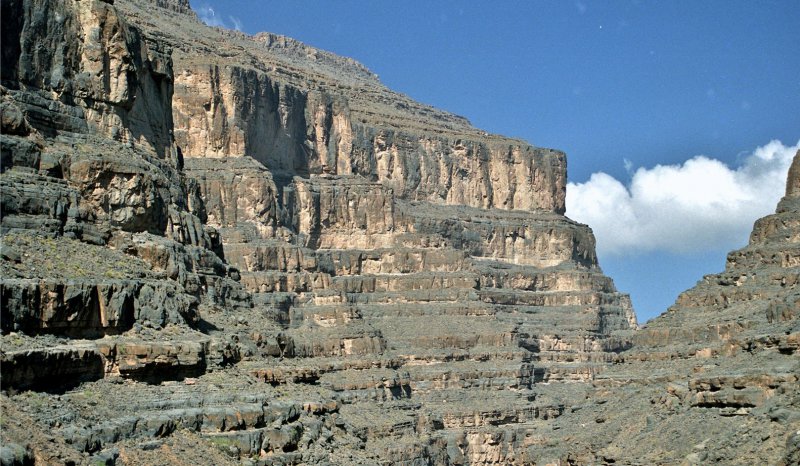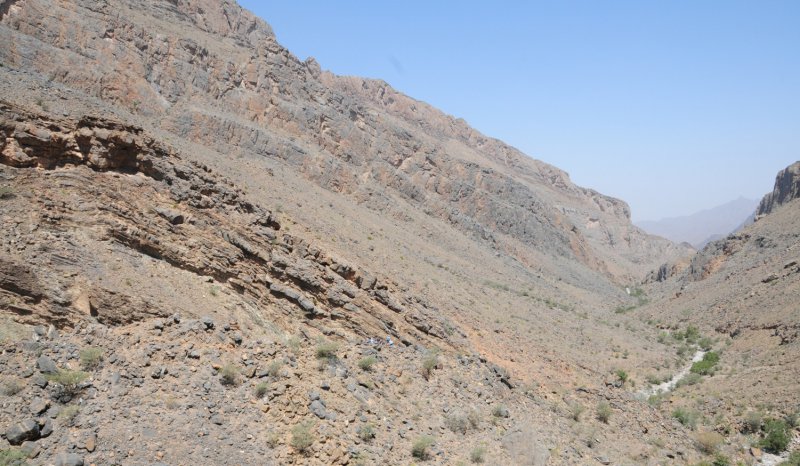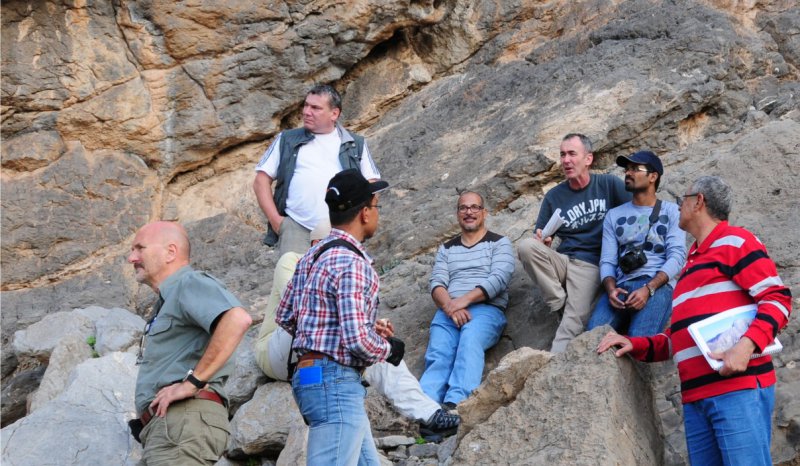Large-Scale Stratal Architecture and Tectono-Stratigraphic Evolution of the Northeast Arabian Platform-Margin: Implications for the Arabian Subsurface
Field seminar to examine outcrops of Permian to Cretaceous carbonates representing analogues to producing Middle East Fields
Location
Northern Oman / Musandam
Objectives
The aims of this field seminar are to:
- examine the large-scale stratal architecture of the Arabian Plate
- Permian to Cretaceous platform-margin as exposed in the northern and Central Oman Mountains
- examine evidence for punctuated syn-sedimentary tectonism
- examine the evidence for a periodically reactivated shelf-edge ‘outer high’, and to consider its significance for intra-shelf basin-fill successions in the Arabian sub-surface
- identify, characterize and trace key Upper Permian to Cretaceous master bounding surfaces in a variety of on-shelf, platform slope, and continental rise settings
- examine superbly exposed carbonate shelf-margin and platform-slope facies tracts
- emphasise the critical importance of platform margin ("offlap break") successions in sequence stratigraphic analysis
Who Should Attend
- Geoscientists wanting to gain a wider (pan-Arabian) perspective of Permian to Cretaceous deposystems and tectono-stratigraphic evolution
- Geologists and seismic interpreters wishing to gain hands-on understanding of the principals of carbonate sequence stratigraphy
- Geoscientists wanting to gain a rapid overview of Arabian Mesozoic geology
- Geoscientists and engineers who want to place their detailed local knowledge within a wider context
Geological Setting
The spectacular outcrops of the northern and central Oman Mountains provide a rare glimpse of the Permian to mid-Cretaceous NE Arabian ocean-facing platform margin. Elsewhere in Arabia this margin has been over-thrust and/or lies deeply buried in the subsurface (as in the Zagros sector), or is otherwise politically inaccessible. The Oman Mountains are unique in this respect.
The world-class seismic-scale outcrops that we will visit in this seminar provide critical context for Arabian subsurface successions, enabling them to be placed within a wider depositional and structural framework. Viewed at this pan-Arabian scale, almost all current production is seen to occupy an interior platform palaeo-setting (though, as we will see, strongly influenced by events at the shelf-margin), while the margin itself remains largely un-explored.
Our itinerary will take in key exposures that provide compelling evidence for synsedimentary tectonism - something that is often suspected in the adjacent sub surface, though definitive evidence is generally lacking. In particular we will consider the evidence for punctuated syn-sedimentary tectonism and for a system of periodically reactivated shelf-edge ‘outer highs’. These provide key insights into intra-platform palaeohighs and intra-shelf basin-fill successions of the adjacent subsurface.
Cycle stacking patterns and large-scale stratal geometries are magnificently (and uniquely) exposed in the northern and central Oman Mountains. Seismic-scale onlap/offlap relationships can be clearly seen, while much of the evidence for sealevel lowstands is exposed here and nowhere else. The visualization thus afforded is invaluable in helping us better understand and constrain correlations, reservoir models and geoseismic sections. It helps us to see the art-of-the-possible (and impossible!) and to keep our interpretations honest.
Note that many, indeed most, of the localities that we will visit lie off the beaten track and remain largely un-described in the literature. The majority of localities do not feature in any other commercially-available fieldtrip itineraries, most of which focus instead on easily accessible roadside localities. There is much of significance here that cannot be gained from textbooks or armchair Google-ing.
By the end of this field workshop participants should (i) have an improved understanding of the context of subsurface successions in the adjacent platform interior, (ii) be more conscious of the influence of synsedimentary tectonism on sequence architecture, and (iii) have less confidence than at the start of this trip in the prophetic power of a one-size-fits-all eustatic curve.
Course Format
This course involves long and moderately strenuous days in the field, with the course format being primarily ‘hands-on’ field discussions supplemented by a comprehensive field manual. We typically conclude the trip with a final half-day classroom round-up session at which participants are split into teams to develop and present a composite tectono-stratigraphic model for the Late Permian to Cretaceous of the NE Arabian platform margin based on localities visited.
Course Details
- Duration: 3-9 days; note that while a few edited highlights could potentially be visited in a short 3-day trip, the localities are widely-spaced geographically, and some of the sites require either a long walk-in or a full-day boat-journey, and a minimum 5-night trip is suggested in order to capture key elements of the stratigraphic framework
- Proposed dates: this trip can be run throughout the Winter field-season from October through to early April each year
- Location: The trip starts and finishes in either Dubai or Abu Dhabi, and takes in Musandam and /or the Central Oman Mountains. Note that the itinerary can be (and usually is) tailored to accommodate specific client objectives.
- Cost: By quotation, includes field transportation, boat hire, instruction, accommodation and a comprehensive field manual.
- This trip involves walking distances of up to 10kms per day in remote mountain terrain. Stout walking boots and a good state of physical fitness are essential.
- Insurance: Participants should ensure that their employers liability insurance cover (including medical insurance) is in order, particularly for personal accident and loss or damage of equipment, as Oolithica Geoscience Ltd cannot accept responsibility for claims arising from this or any other field seminar
- Attendance Limit: minimum 3, maximum 11 participants













